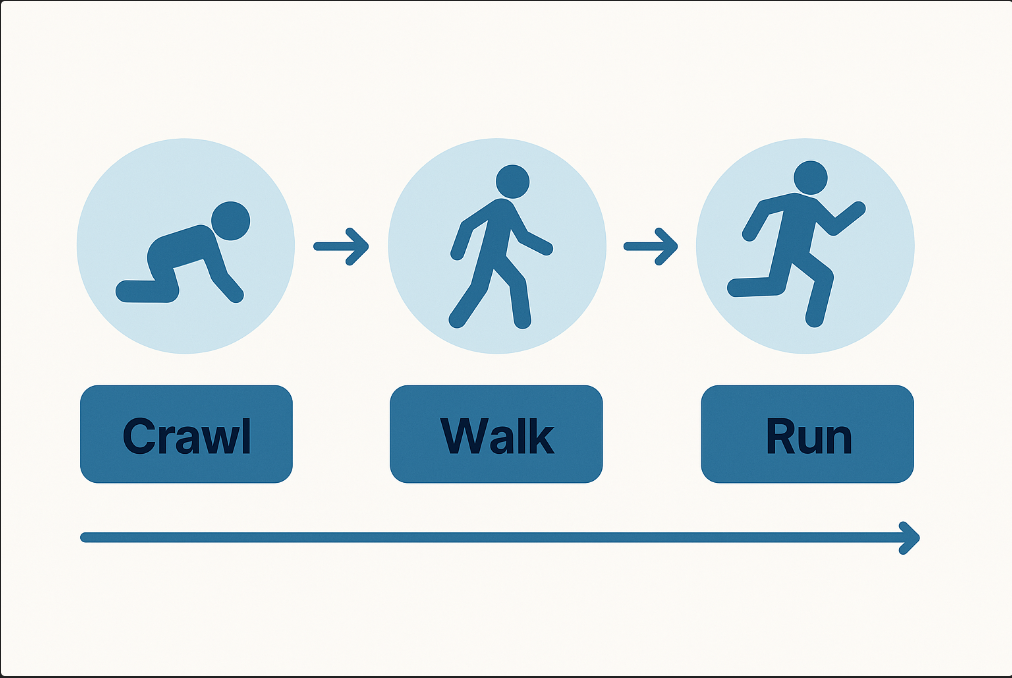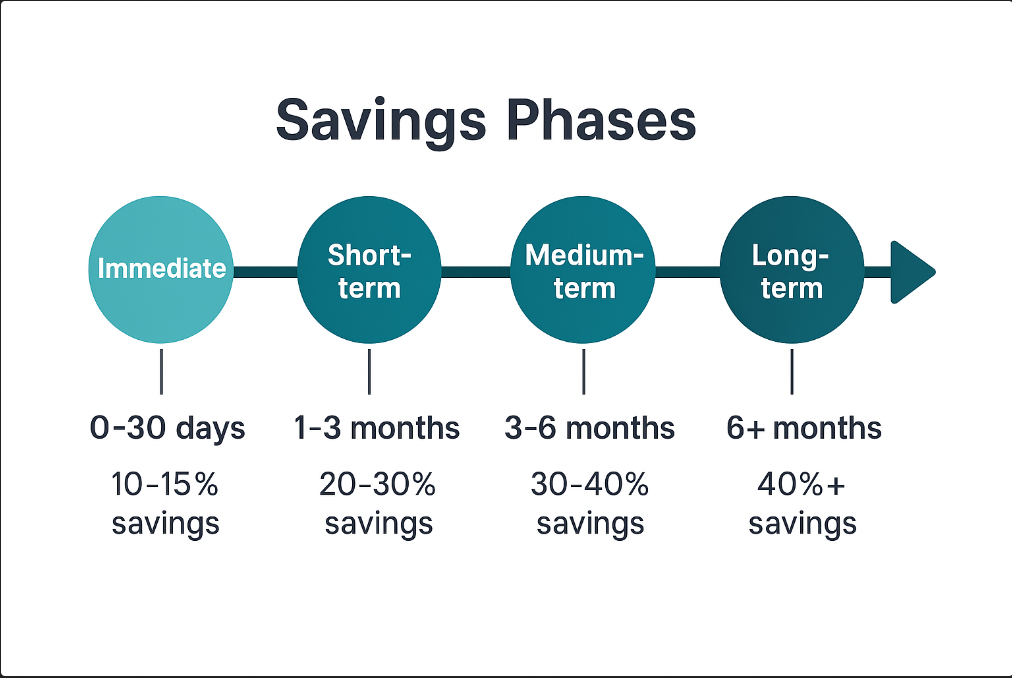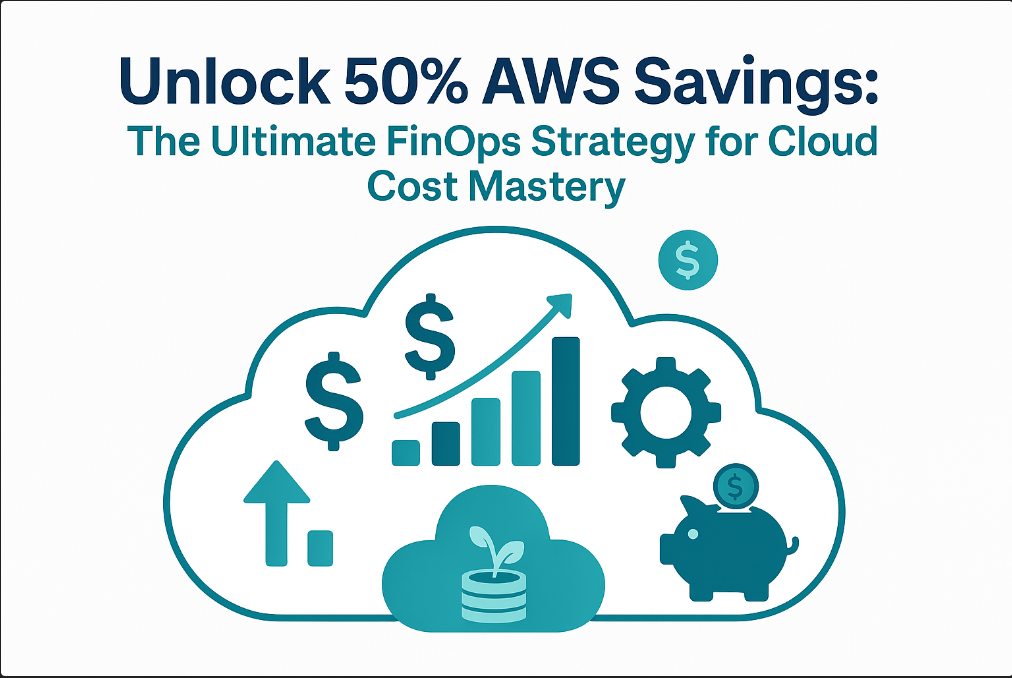Here’s a sobering reality check: Companies without dedicated FinOps expertise overspend on AWS by an average of 28–35%, according to our analysis of over 500 cloud environments. That’s not just wasteful spending-it’s strategic capital hemorrhaging into the void while your competitors optimize their way to market advantage.
The problem isn’t that organizations don’t care about cloud costs. It’s that they’ve relegated FinOps to a “when we get around to it” initiative, treating it like an operational afterthought rather than the strategic growth lever it should be.
This comprehensive guide will show you how to elevate FinOps maturity from a reactive cost-cutting exercise to a proactive business acceleration engine. You’ll discover the proven framework that transforms FinOps from organizational friction into competitive advantage—and why the companies that master this transformation will dominate their markets in the AI-first economy.
The FinOps Side Hustle Problem: When Good Intentions Meet Bad Outcomes
Picture this: It’s 3 AM, and your Slack notifications are exploding. Your AI team just spun up a new machine learning workload for “quick testing,” provisioning GPU instances across multiple regions. By morning, your AWS bill has spiked by $45,000—overnight.
Sound familiar? This scenario plays out in organizations worldwide, not because teams are reckless, but because FinOps exists in a dangerous gray area of split accountability.
Why FinOps Gets Pushed to the Sidelines
Split Accountability Between Finance and Engineering
Finance teams understand budgets but lack technical context for cloud resource decisions. Engineering teams optimize for velocity and performance but often operate without cost guardrails. The result? A coordination failure that leaves no one truly accountable for cost outcomes.
No Clear KPIs Tied to Business Goals
Most organizations track cloud spending in isolation—total AWS bill, month-over-month growth, departmental allocations. But these metrics don’t connect to business value. What’s the cost per feature shipped? Per customer acquired? Per AI model trained? Without these connections, FinOps becomes an abstract cost center rather than a strategic enabler.
Reactive, Not Proactive Approach
The typical FinOps cycle looks like this: Spend money, measure impact weeks later, react to surprises, repeat. By the time you identify waste, you’ve already paid for it. In fast-moving AI and SaaS environments, this reactive approach can cost millions annually.
Real-World Impact: A Costq.ai Case Study
One of our SaaS clients discovered they were spending $2.3M annually on idle resources—compute instances, databases, and storage volumes that served no active purpose. Their part-time FinOps approach meant these resources ran for months before detection.
After implementing strategic FinOps practices, they achieved:
- 47% reduction in total AWS spending
- 89% faster detection of cost anomalies
- $1.1M reinvested into product development
- 23% improvement in feature delivery velocity
The High Cost of Immature FinOps: Where Strategic Capital Goes to Die
AI Budget Shock: GPU Workloads Without Guardrails
Artificial intelligence workloads represent the fastest-growing segment of cloud spending, yet they’re often the least governed. A single unmonitored training job can consume thousands of dollars in GPU compute before anyone notices.
Consider the economics: A p4d.24xlarge instance costs $32.77 per hour. Run that for a month, and you’ve spent $23,595. Multiply across multiple data scientists experimenting with different models, and costs spiral exponentially.
Without proper FinOps governance:
- 73% of AI workloads run longer than necessary
- 45% of GPU instances remain idle during off-hours
- 62% of organizations lack automated shutoff policies for experimental workloads
Idle Commitments: Reserved Instances and Savings Plans Left Unused
Reserved Instances and Savings Plans offer 30–75% discounts on compute costs, making them essential for mature FinOps operations. However, many organizations purchase these commitments reactively, leading to massive waste.
Common commitment management failures:
- Over-commitment: Purchasing more capacity than actual usage patterns support
- Under-utilization: Failing to modify applications to leverage committed capacity
- Poor planning: Buying commitments without considering business growth or technology changes
The result? Organizations pay for discounted capacity they don’t use while paying on-demand rates for capacity they do use—the worst of both worlds.
Shadow IT Services: Unapproved SaaS Tools Draining Spend
While everyone focuses on infrastructure costs, shadow IT services quietly drain budgets through unapproved SaaS subscriptions, redundant tooling, and unmanaged integrations.
Typical shadow IT cost drains include:
- Multiple monitoring tools serving the same function
- Abandoned AI/ML platforms with recurring charges
- Development tools purchased by individual teams without coordination
- Third-party APIs with usage-based pricing and no governance
These costs often escape traditional FinOps visibility because they’re scattered across departments and payment methods.
The FinOps Maturity Model: Your Roadmap to Strategic Cloud Cost Management
Understanding where your organization sits on the FinOps maturity spectrum is crucial for planning your evolution from reactive cost management to strategic advantage.
Stage 1: Foundational FinOps (Crawl)
Characteristics:
- Manual cost reporting through spreadsheets and dashboards
- Monthly or quarterly cost reviews
- Basic resource tagging (if any)
- Cost allocation by department or project
- Reactive optimization efforts
Typical Results:
- 15–25% cost visibility
- 3–6 month lag on optimization implementation
- Limited ability to predict or prevent cost spikes
- Optimization efforts yield 10–15% savings
Costq.ai Foundation Tools:
- Automated cost reporting and alerting
- Real-time spend visibility across all AWS services
- Basic anomaly detection for unusual spending patterns
- Simplified cost allocation and chargeback reporting
Stage 2: Operational FinOps (Walk)
Characteristics:
- Automated reporting and regular optimization cadences
- Dedicated FinOps practitioner (often part-time)
- Established cost governance policies
- Proactive Reserved Instance and Savings Plan management
- Integration with engineering workflows
Typical Results:
- 50–70% cost visibility and attribution
- 1–2 week lag on optimization implementation
- Predictable cost forecasting within 10–15% accuracy
- Optimization efforts yield 20–30% savings
Costq.ai Operational Tools:
- Automated RI and Savings Plan recommendations
- Policy-based resource governance and enforcement
- Integration with CI/CD pipelines for cost awareness
- Advanced cost attribution and showback capabilities
Stage 3: Strategic FinOps (Run)
Characteristics:
- FinOps integrated into business planning and product decisions
- Predictive analytics and machine learning for cost optimization
- Real-time cost awareness in development and deployment processes
- FinOps KPIs aligned with business outcomes
- Cultural shift toward cost consciousness throughout the organization
Typical Results:
- 90%+ cost visibility and attribution
- Real-time optimization and prevention
- Cost forecasting within 5% accuracy
- Optimization efforts yield 35–50% savings while accelerating innovation
Costq.ai Strategic Tools:
- AI-powered predictive cost modeling
- Real-time optimization recommendations and automated actions
- Business outcome correlation and unit economics tracking
- Advanced governance with automated policy enforcement
Learn more about best practices for cloud cost governance.
The Strategic FinOps Blueprint: Transforming Cost Management into Competitive Advantage
5.1 Appoint a Full-Time FinOps Lead
The single most impactful decision you can make is hiring a dedicated FinOps professional. This isn’t a role that can be effectively managed as a side responsibility.
FinOps Lead Role Description:
- Primary Responsibility: Optimize cloud spending to maximize business value
- Key Skills: Technical cloud expertise + financial acumen + business strategy
- Reporting Structure: Direct line to CTO or CFO with cross-functional authority
- Success Metrics: Cost per unit of business value, optimization savings, forecast accuracy
Essential KPIs for FinOps Leaders:
- Cost per customer/transaction/feature
- Optimization savings as % of total spend
- Forecast accuracy (target: within 5% monthly)
- Time from anomaly detection to resolution
- Engineering team adoption of cost-conscious practices
Organizational Alignment Strategies:
- Monthly FinOps reviews with executive team
- Quarterly optimization roadmap planning
- Cost-awareness training for engineering teams
- Integration with product planning and architecture decisions
5.2 Build the Governance Playbook
Successful FinOps requires systematic processes that prevent problems before they occur and optimize continuously.
Weekly Cost Review Checklist:
- [ ] Review top 10 cost-driving services and usage patterns
- [ ] Analyze week-over-week spending variations >10%
- [ ] Check Reserved Instance and Savings Plan utilization rates
- [ ] Validate cost allocation and tagging compliance
- [ ] Identify and flag idle or underutilized resources
- [ ] Review and approve upcoming high-cost deployments
Monthly Optimization Sprint Framework:
- Week 1: Cost analysis and opportunity identification
- Week 2: Optimization strategy development and stakeholder alignment
- Week 3: Implementation and testing
- Week 4: Results validation and process refinement
Quarterly Cloud Cost Forecasting Template:
- Business growth projections and resource requirements
- Seasonal usage patterns and capacity planning
- Technology roadmap impact on infrastructure needs
- Optimization initiatives and expected savings
- Risk scenarios and contingency planning
5.3 Automate High-Impact Actions
Manual optimization efforts don’t scale with business growth. Automation is essential for maintaining FinOps effectiveness as your cloud environment expands.
Idle Resource Termination:
- Automated shutdown of non-production resources during off-hours
- Identification and termination of truly idle resources (unused EBS volumes, stopped instances with EBS storage, unused elastic IPs)
- Grace period notifications before automated actions
- Exception handling for critical resources
Commitment Management:
- Automated Reserved Instance and Savings Plan recommendations based on actual usage patterns
- Dynamic commitment modifications as usage patterns change
- Utilization monitoring and reallocation across accounts/regions
- Expiration tracking and renewal planning
Real-Time Anomaly Detection:
- Machine learning-based spending pattern analysis
- Immediate alerts for unusual cost spikes (configurable thresholds)
- Automatic investigation workflows to identify root causes
- Integration with incident response processes
5.4 Integrate into Engineering Workflows
The most effective cost optimizations happen before resources are provisioned, not after. This requires embedding cost awareness into development and deployment processes.
Pre-Deployment Cost Checks in CI/CD:
- Infrastructure-as-code cost estimation before deployment
- Automated cost impact analysis for architecture changes
- Resource sizing recommendations based on similar workloads
- Approval workflows for high-cost deployments
Cost Tagging Standards:
- Mandatory tags for cost allocation (project, team, environment, owner)
- Automated tag compliance checking and enforcement
- Cost showback and chargeback based on tagging
- Tag-based policy enforcement (budget limits, resource constraints)
Developer Cost Awareness Tools:
- Real-time cost visibility in development environments
- Cost estimates for proposed changes
- Historical cost trends for services and features
- Cost optimization recommendations integrated into development workflows
5.5 Tie Savings to Innovation
The ultimate goal isn’t just cost reduction—it’s capital reallocation toward higher-value activities that drive business growth.
Savings Reinvestment Framework:
- Track and report cost optimizations as “innovation credits”
- Establish clear processes for reinvesting savings into product development
- Create visibility into how cost optimizations fund new initiatives
- Measure business impact of reinvested capital
Examples of Strategic Reinvestment:
- Redirect compute savings toward AI/ML research and development
- Fund additional development teams with infrastructure optimization savings
- Invest in advanced tooling and automation to further accelerate optimization
- Support experimentation and innovation with freed-up capital
Competitive Advantage: Strategic vs. The Side Hustle Approach
| Criteria | Side Hustle FinOps | Strategic FinOps (Costq.ai) |
|---|---|---|
| Speed to Insight | Monthly reports | Real-time visibility |
| Governance | Ad-hoc meetings | Structured, automated |
| AI Cost Control | Non-existent | Automated guardrails |
| Optimization | Manual, reactive | AI-powered, proactive |
| Business Alignment | Cost center focus | Growth enablement |
| Forecast Accuracy | ±20-30% | ±5% with ML models |
| Team Productivity | Distracted by cost fires | Focused on value creation |
| Innovation Speed | Slowed by budget constraints | Accelerated by optimized spend |
Real-World Case Studies: Strategic FinOps in Action
Case Study 1: SaaS Platform Achieves 42% Cost Reduction in 90 Days
Challenge:
A rapidly growing SaaS platform was experiencing exponential AWS cost growth that outpaced revenue growth. Monthly bills had increased from $180k to $520k in six months, with no clear understanding of cost drivers.
Solution:
Implementation of strategic FinOps practices including:
- Dedicated FinOps lead appointment
- Automated cost anomaly detection
- Reserved Instance optimization program
- Right-sizing initiative for oversized instances
- Automated idle resource cleanup
Results:
- 42% reduction in monthly AWS spending ($520k → $301k)
- 89% faster detection of cost anomalies
- $2.6M annual savings redirected to product development
- 31% improvement in engineering team productivity (less time fighting cost fires)
- 18% acceleration in feature delivery velocity
Case Study 2: AI Research Company Optimizes $1M Annual GPU Spend
Challenge:
An AI research company was spending $1.2M annually on GPU compute for machine learning workloads, with no visibility into utilization patterns or optimization opportunities.
Solution:
Advanced FinOps implementation focused on AI workload optimization:
- GPU utilization monitoring and right-sizing
- Automated scheduling for non-critical training jobs
- Spot instance integration for fault-tolerant workloads
- Reserved Instance strategy for predictable base capacity
Results:
- $487k annual savings (41% cost reduction)
- 67% improvement in GPU utilization rates
- 2.3x increase in ML experiments per dollar spent
- 45% reduction in time-to-model for production deployments
Advanced Tactics: The Cutting Edge of Cloud Cost Management

Predictive Anomaly Detection for AI Workloads
Traditional anomaly detection relies on historical patterns, but AI workloads are inherently unpredictable. Advanced FinOps practices use machine learning to predict cost anomalies before they occur.
Key Techniques:
- Behavioral modeling of ML training patterns
- Predictive scaling based on model complexity and dataset size
- Early warning systems for runaway training jobs
- Automated circuit breakers for cost thresholds
Unit Economics Tracking Per Customer, Feature, and Transaction
The most sophisticated FinOps organizations track costs at the unit level—understanding exactly how much each customer, feature, or transaction costs to serve.
Implementation Approach:
- Infrastructure cost allocation based on actual resource usage
- Application-level instrumentation for cost attribution
- Real-time unit economics dashboards
- Cost-per-feature analysis for product prioritization
FinOps as Part of FinTech Governance
For financial services organizations, FinOps governance must integrate with broader regulatory and compliance requirements.
Special Considerations:
- Cost controls aligned with risk management frameworks
- Audit trails for all optimization actions
- Compliance-aware resource provisioning
- Cost allocation for regulatory reporting
Implementation Checklist: Your 90-Day Transformation Plan
Phase 1: Foundation (Days 1-30)
Week 1: Assessment and Planning
- [ ] Complete FinOps maturity self-assessment
- [ ] Audit current cloud spending and identify top cost drivers
- [ ] Map existing cost management processes and stakeholders
- [ ] Define FinOps goals and success metrics
Week 2: Team and Tools
- [ ] Hire or designate dedicated FinOps lead
- [ ] Implement cost visibility and reporting tools
- [ ] Establish basic cost allocation and tagging standards
- [ ] Create FinOps communication channels and cadences
Week 3: Quick Wins
- [ ] Identify and terminate idle resources
- [ ] Right-size obviously oversized instances
- [ ] Implement basic Reserved Instance recommendations
- [ ] Set up cost anomaly alerting
Week 4: Governance Foundation
- [ ] Establish weekly cost review process
- [ ] Create cost approval workflows for large deployments
- [ ] Begin engineering team cost awareness training
- [ ] Document initial FinOps playbook
Phase 2: Operational Excellence (Days 31-60)
Week 5-6: Automation Implementation
- [ ] Deploy automated resource optimization tools
- [ ] Integrate cost checks into CI/CD pipelines
- [ ] Implement advanced Reserved Instance management
- [ ] Set up automated cost reporting and showback
Week 7-8: Process Optimization
- [ ] Refine cost allocation and chargeback processes
- [ ] Expand cost tagging and compliance automation
- [ ] Implement monthly optimization sprint cadence
- [ ] Begin unit economics tracking for key business metrics
Phase 3: Strategic Integration (Days 61-90)
Week 9-10: Advanced Analytics
- [ ] Implement predictive cost modeling
- [ ] Deploy machine learning-based anomaly detection
- [ ] Create cost forecasting and capacity planning processes
- [ ] Integrate FinOps metrics with business KPIs
Week 11-12: Cultural Transformation
- [ ] Complete organization-wide cost awareness training
- [ ] Integrate cost considerations into product planning
- [ ] Establish innovation reinvestment processes
- [ ] Measure and celebrate FinOps success stories
Frequently Asked Questions
1. What is a FinOps lead and do I need one?
A FinOps lead is a dedicated professional responsible for optimizing cloud spending to maximize business value. Unlike traditional IT cost management, FinOps leads bridge technical and financial expertise to make strategic decisions about cloud investments.
You need a dedicated FinOps lead if:
- Your monthly cloud spending exceeds $50k
- You’re experiencing unpredictable cost spikes
- Engineering teams lack visibility into cost implications of their decisions
- You’re unable to forecast cloud costs within 15% accuracy
2. How do I measure FinOps maturity?
It is measured across several dimensions:
- Visibility: Can you attribute 90%+ of cloud costs to specific business activities?
- Optimization: Are you achieving 25%+ savings through systematic optimization?
- Governance: Do you have automated policies preventing cost waste?
- Culture: Are engineers making cost-conscious decisions without friction?
- Business Alignment: Are FinOps metrics tied to business outcomes?
Use our Maturity Assessment tool to benchmark your current state and identify improvement opportunities.

3. What KPIs should FinOps track?
Essential KPIs include:
Financial Metrics:
- Cost per unit of business value (customer, transaction, feature)
- Optimization savings as percentage of total spend
- Forecast accuracy (target: within 5% monthly)
- Reserved Instance and Savings Plan utilization rates
Operational Metrics:
- Time from cost anomaly detection to resolution
- Percentage of resources with proper cost allocation tags
- Engineering team adoption of cost-conscious practices
- Idle resource percentage and cleanup time
Strategic Metrics:
- Innovation investment funded by cost optimizations
- Feature delivery velocity improvement
- Cost avoidance through proactive governance
4. How soon can I expect AWS savings?
Savings timeline depends on your starting maturity and implementation approach:
- Immediate (0-30 days): 10-15% savings through idle resource cleanup and basic right-sizing
- Short-term (1-3 months): 20-30% savings through Reserved Instance optimization and automated policies
- Medium-term (3-6 months): 30-40% savings through advanced optimization and workflow integration
- Long-term (6+ months): 40%+ savings through predictive optimization and cultural transformation
The key is starting with quick wins while building toward systematic, long-term optimization.

Take Action: Transform Your Strategy Today
The cloud cost optimization landscape is evolving rapidly. Organizations that treat FinOps as a strategic capability will achieve sustainable competitive advantages, while those that continue treating it as a side hustle will find themselves at an increasing disadvantage.
Get Your Free FinOps Readiness Audit
Ready to discover how much your organization could save with strategic practices? Costq.ai offers a comprehensive Readiness Audit that identifies your biggest optimization opportunities and provides a customized roadmap for transformation.
What’s Included:
- Complete analysis of your current AWS spending patterns
- Identification of immediate cost optimization opportunities
- Maturity assessment and benchmarking
- 90-day transformation roadmap tailored to your organization
- ROI projections for investments
Get Started Today:
Transform your cloud costs from a necessary evil into your strongest competitive advantage. The time for strategic FinOps is now.
